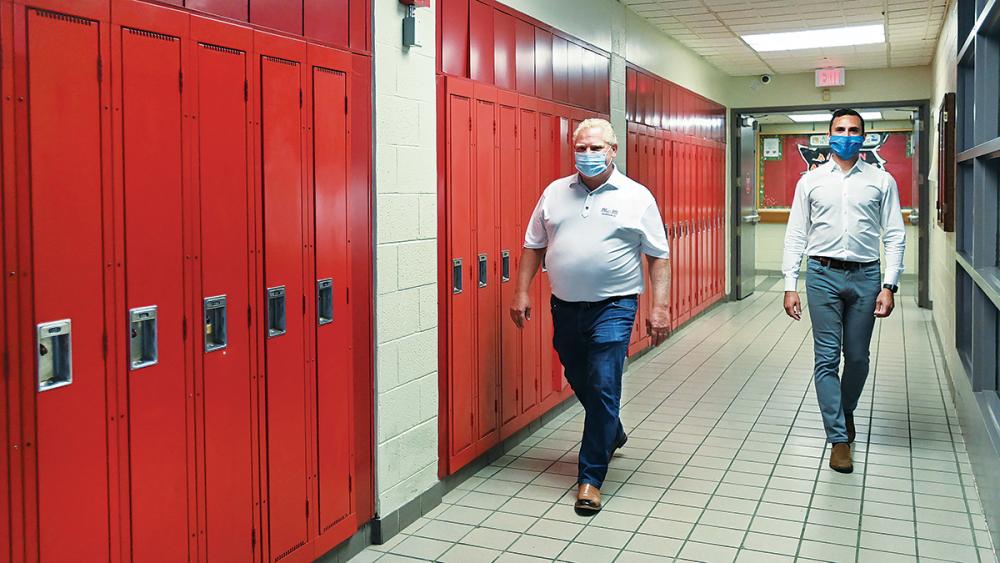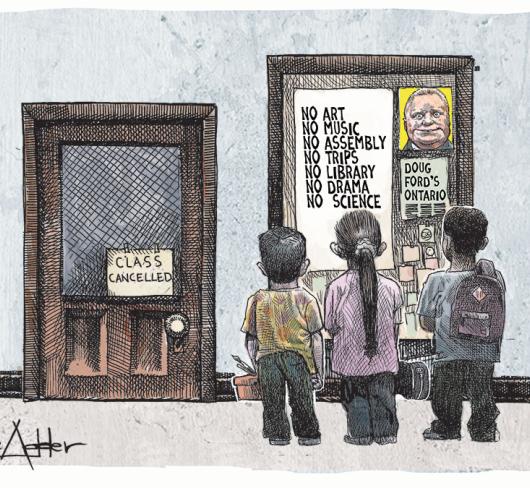
True Colours
The Ford government’s shocking lack of action on school safety in the wake of the pandemic is a stark reminder of their contempt for public education in general – and educators in particular.
On March 12, 2020 the Ford government announced that public schools across Ontario would be closed for a period of two weeks following March break in response to the emerging public health crisis triggered by the global COVID-19 pandemic. This two week period was later extended, resulting in students finishing the school year engaged in emergency distance learning.
During these early stages of our province’s response to the pandemic, the Premier promised Ontarians that “no expense would be spared” to keep us safe. Unfortunately, the often-repeated promise to do whatever is necessary to keep people safe, turned out to be more of an exercise in public relations than a guiding principle for the government’s response to the pandemic.
During the months that followed the initial closure of schools; students, educators and the public witnessed a government that squandered critical planning time. When they finally released their plan at the end of the summer, it was widely criticized for falling short of providing a safe reopening for students and educators and ultimately raised more anxiety for communities across the province.
During the summer months, the Ford government refused to take a proactive and cautious approach, instead adopting a philosophy of making only the investments they were forced to make in order to appease an increasingly concerned public. In this climate, the ongoing advocacy by ETFO and other education unions, public education advocates, parent organizers, public health experts and thousands of Ontarians proved crucial in forcing the government to implement many of the health and safety measures that are in place in schools across Ontario today.
During the first few weeks of the pandemic’s arrival to Ontario, the government received a relatively positive response from critics and supporters alike. The government decided to place the Premier at the centre of its public response while claiming to always be acting on the advice of the Chief Medical Officer of Health and other public health officials. The government also managed to claim credit for much of the public investment that occurred during the early months of the pandemic, despite the fact that the lion’s share of that spending came from the Federal Government.
This clever communication strategy, coupled with the lowering of expectations in Ontario brought on by the jaw-dropping mishandling of the pandemic by the Trump administration in the United States, resulted in a much more favourable response from Ontarians to the government’s handling of the pandemic than a sober analysis would have warranted.
However, instead of using that newly-found goodwill to build a truly broad and unified response to the public health crisis, the Ford government chose instead to follow the same script it did prior to the pandemic: protect the interests of wealthy corporations and well-connected political allies and minimize public investment.
When responding to the need of workers to access paid sick leave in order to comply with self-isolation guidelines from public health, the government instead implemented job-protected unpaid leave. When faced with an emerging crisis in Ontario’s long-term care homes, the government delayed its response and focused on protecting for-profit operators from liability. It should have come as no surprise then, that when faced with the need to plan for the reopening of schools, the Ford government sought to do everything possible to avoid investing in public education.
While the Minister of Education routinely tries to convince Ontarians that his government has made historic investments in public education, the reality is that when the government announced the funding allocation for the 2020-21 school year on June 19, 2020, only $25 million in additional funding had been set aside for COVID-19 related expenses. The rest of the government’s response relied on redirecting existing funding from other key areas.
After mounting pressure from educators, their unions, parents and an increasingly worried public, the government was forced to both amend its plan on several occasions and make the accompanying additional investments; all the while continuing to resist the public demands to be more cautious than austere and refusing to implement the safety measures that carried a larger price tag.
In early August, the government reported on its first quarter finances for 2020- 21. In this report, the government claimed that its overall response to the COVID-19 pandemic amounts to approximately $30 billion. By mid-August, the total amount of additional investments allocated by the government for the 2020-21 school year, in response to public pressure, was under $400 million. This represents a little over one per cent of the provincial government’s response to COVID-19.
The consistent refusal to mandate lower class sizes in the elementary grades and allocate the necessary funding to do so, showed Ontarians that this government was only willing to implement those health and safety measures that fit its existing fiscal framework for public education. Put in other words, the government’s approach to safety in our schools was to shape measures to fit its budget, rather than to shape its budget to fit the necessary measures.
When it could no longer manage the public pressure to reduce class sizes to allow for proper physical distancing, the government decided to pass the buck to school boards by “allowing” them to use their own reserves to implement lower class sizes. This was a stunning admission by the government that its plan was not good enough. But true to form, the Ford government found a way not to pay for it, and instead forced school boards to re-direct funding from other needs in the system. Ontarians will certainly remember this striking lack of leadership by the Premier and his Minister of Education as we head into the next provincial election.
Facing a government intent on not making the necessary investments, the work that ETFO and its members did over the summer produced results that we can all be proud of: access to masks and personal protective equipment for all educators, mandatory masks for students from grades 4 and above, strengthened cleaning and disinfecting protocols, and efforts to reduce class sizes in several school boards. As I write this in August, ETFO continues to advocate for smaller classes to ensure proper physical distancing, enhanced ventilation for all schools and classrooms and mandatory masks for all students.
The role that Ontario’s public schools will play in the trajectory of the COVID-19 pandemic over the coming months remains uncertain. What is certain is that the Ford government cannot be trusted to make decisions that will prioritize the safety of students, educators and their families. Ongoing advocacy by ETFO, its members, parents and supporters of public education will continue to be critical to keep this government in check.
Educators will continue their work alongside parents and allies to ensure that this government, and future ones, make the necessary investments not only to provide students and educators with healthy and safe school environments, but to continue to provide high-quality public education that is centred on equity and inclusion.
The global pandemic has put in stark contrast the diverging views of the role of public health care, public education and other public services that currently exist in our province. As we continue to collectively deal with the health, social and economic impacts of COVID-19, we must consider the role that our public services will play in the recovery that will follow in the coming years. Those who have long sought to turn over a growing portion of our public services, including public education, to for-profit corporations, have already set their lobbying machinery in motion.
Advocates for public education will need to be ready to ensure that in the next provincial election, Ontarians choose a path to recovery that relies on strengthening our public services not undermining them. A path that choses public investment over austerity.
In order to rebuild Ontario’s economy and social infrastructure we will need to invest in high-quality, inclusive, equitable and accessible public education. The Ford government has shown us that they are incapable of doing so. ETFO members should get ready to play an active role in mobilizing their communities for progressive change in Ontario.
If you haven’t already done so, please sign up at BuildingBetterSchools.ca and join the campaign to defend and strengthen public education.
Federico Carvajal is a member of ETFO Executive Staff.
